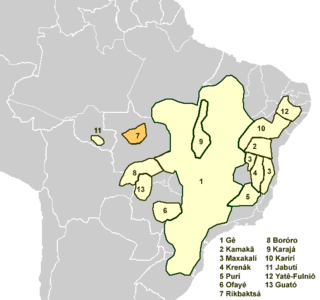Related Research Articles

In phonology, an allophone is one of multiple possible spoken sounds – or phones – used to pronounce a single phoneme in a particular language. For example, in English, the voiceless plosive and the aspirated form are allophones for the phoneme, while these two are considered to be different phonemes in some languages such as Central Thai. Similarly, in Spanish, and are allophones for the phoneme, while these two are considered to be different phonemes in English.
Berta proper, a.k.a. Gebeto, is spoken by the Berta in Sudan and Ethiopia. As of 2006 Berta had approximately 180,000 speakers in Sudan.
Turkana is the language of the Turkana people of Kenya and Ethiopia. It is spoken in northwestern Kenya, primarily in Turkana County, which lies west of Lake Turkana. It is one of the Eastern Nilotic languages, and is closely related to Karamojong, Jie and Teso of Uganda, to Toposa spoken in the extreme southeast of South Sudan, and to Nyangatom in the South Sudan/Ethiopia Omo valley borderland; these languages together form the cluster of Ateker Languages.
The phonology of the Persian language varies between regional dialects, standard varieties, and even from older varieties of Persian. Persian is a pluricentric language and countries that have Persian as an official language have separate standard varieties, namely: Standard Dari (Afghanistan), Standard Iranian Persian (Iran) and Standard Tajik (Tajikistan). The most significant differences between standard varieties of Persian are their vowel systems. Standard varieties of Persian have anywhere from 6 to 8 vowel distinctions, and similar vowels may be pronounced differently between standards. However, there are not many notable differences when comparing consonants, as all standard varieties have a similar number of consonant sounds. Though, colloquial varieties generally have more differences than their standard counterparts. Most dialects feature contrastive stress and syllable-final consonant clusters. Linguists tend to focus on Iranian Persian, so this article may contain less adequate information regarding other varieties.
The Lotha language is a Sino-Tibetan language spoken by approximately 180,000 people in Wokha district of west-central Nagaland, India. It is centered in the small district of Wokha. This district has more than 114 villages such as Pangti, Maraju (Merapani), Englan, Baghty (Pakti) and others, where the language is widely spoken and studied.
Kuman is a language of Chimbu Province, Papua New Guinea. In 1994, it was estimated that 80,000 people spoke Kuman, 10,000 of them monolinguals; in the 2000 census, 115,000 were reported, with few monolinguals. Ethnologue also reported 70,000 second language speakers in 2021.
The Korean language, known for its unique phonetic system, comprises 19 distinct consonant phonemes that exhibit a rich variety of articulatory features. Unlike many languages, Korean consonants are categorized into three main types: plain, tense, and aspirated, each contributing to the language's distinctive soundscape. Also, Korean phonology is characterized by a complex system of classification and pronunciation rules that play a crucial role in the language's phonetic and phonological structure.
Semelai is an Austroasiatic language spoken in the Malay Peninsula. It belongs to the Southern branch of the Aslian language subgrouping. The Semelai people reside predominantly around the Bera, Serting and associated river systems in the states of Pahang, Negeri Sembilan and Johor.

The Rikbaktsa language, also spelled Aripaktsa, Erikbatsa or Erikpatsa and known ambiguously as Canoeiro, is a language spoken by the Rikbaktsa people of Mato Grosso, Brazil, that forms its own branch of the Macro-Gê languages.
The phonology of the Zuni language as spoken in the southwestern United States is described here. Phonology is a branch of linguistics that studies how languages or dialects systematically organize their sounds.
Amdo Tibetan is the Tibetic language spoken in Amdo. It has two varieties, the farmer dialects and the nomad dialects.
Benabena (Bena) is a Papuan language spoken in the Goroka District of Eastern Highlands Province, Papua New Guinea.
Gwari is a Nupoid language spoken by the Gbagyi people, which make up over a million people in Nigeria. There are two principal varieties, Gbari and Gbagyi, which have some difficulty in communication; sociolinguistically they are distinct languages.
Yamdena is an Austronesian language of Yamdena and surrounding islands in the Maluku Islands in Indonesia. In 1991 there were an estimated 25,000 speakers of the language. Current BPS data has the present number of speakers at 69,000.
Avava (Navava), also known as Katbol, Tembimbe-Katbol, or Bangsa’ is an Oceanic language of central Malekula, Vanuatu. It has nasalized fricatives and a bilabial trill.
Mengen and Poeng are rather divergent dialects of an Austronesian language of New Britain in Papua New Guinea.
Lenakel, or West Tanna, is a dialect chain spoken on the western coast of Tanna Island in Vanuatu.
Maskelynes, or Kuliviu (Uliveo), is an Oceanic language spoken on the Maskelyne Islands off south Malekula, Vanuatu.
Gumuz is a dialect cluster spoken along the border of Ethiopia and Sudan. It has been tentatively classified within the Nilo-Saharan family. Most Ethiopian speakers live in Kamashi Zone and Metekel Zone of the Benishangul-Gumuz Region, although a group of 1,000 reportedly live outside the town of Welkite. The Sudanese speakers live in the area east of Er Roseires, around Famaka and Fazoglo on the Blue Nile, extending north along the border. Dimmendaal et al. (2019) suspect that the poorly attested varieties spoken along the river constitute a distinct language, Kadallu.
Manyjilyjarra is generally considered a dialect of the Western Desert language.
References
- ↑ Ot Danum at Ethnologue (18th ed., 2015) (subscription required)
- ↑ Bamba, John (ed.) (2008). Mozaik Dayak keberagaman subsuku dan bahasa Dayak di Kalimantan Barat. Pontianak: Institut Dayakologi. ISBN 978-979-97788-5-7.
- ↑ Inagaki, Kazuya (2005). Phonemic sketch of Dohoi/Kadorih. Kyoto University Linguistic Research 24: Kyoto University Research Information Repository. pp. 15–43.
{{cite book}}: CS1 maint: location (link)